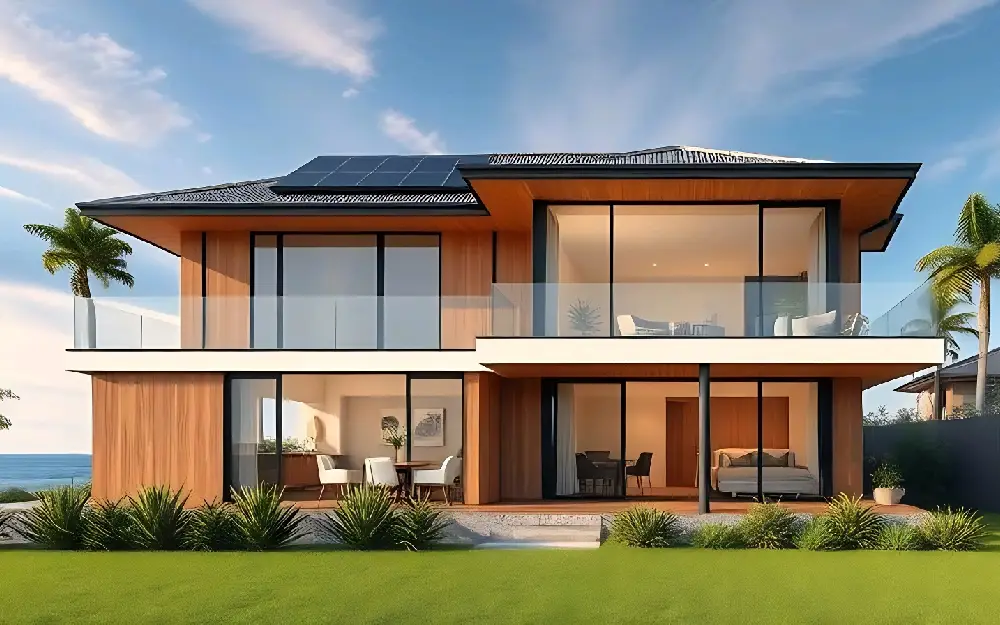
The Impact of Climate on New Home Design: Adapting to Environmental Changes
As climate change continues to shape the world, it’s becoming more important than ever to consider environmental factors when designing and building homes. The weather patterns, temperature fluctuations, and regional conditions all play a major role in how homes are built and maintained. Home design is no longer just about aesthetics and functionality; it’s increasingly about resilience, sustainability, and adaptability to the changing climate.
1. Designing for Extreme Weather Events
As the frequency of extreme weather events increases — from hurricanes and tornadoes to wildfires and floods — homeowners and builders must consider ways to protect the home from potential disasters. In flood-prone areas, homes are being elevated above flood levels, with raised foundations and waterproof materials used to minimize water damage.
In regions with wildfires, fire-resistant materials are becoming a standard. Homes in these areas might feature fireproof roofing, siding, and windows, as well as defensible spaces that are cleared of dry vegetation. The focus is on minimizing damage and creating buildings that can withstand the harshest of conditions.
2. Energy Efficiency in Hot and Cold Climates
Climate plays a significant role in shaping a home’s energy needs. In areas with hot climates, such as the southern United States or desert regions, homes are increasingly designed to keep cool without relying heavily on air conditioning. Features like reflective roofing, strategically placed windows, thick insulation, and natural ventilation systems help minimize the need for cooling energy.
On the other hand, in cold climates, homes are being built with thermal insulation, airtight designs, and advanced heating systems that maximize energy efficiency and minimize heat loss. Triple-glazed windows and weather-resistant doors are standard, ensuring that the heat stays in and the cold stays out.
3. Incorporating Renewable Energy Sources
The shift towards renewable energy is perhaps one of the most noticeable changes in new home design. Solar panels, wind turbines, and geothermal heating systems are becoming more common as homeowners look to reduce their carbon footprint and become less reliant on traditional energy sources. In areas with abundant sunshine, solar panels are a no-brainer, while in colder regions, geothermal heating systems are being installed to tap into the Earth’s natural heat.
Incorporating renewable energy sources not only helps reduce a home's environmental impact but also provides homeowners with greater energy independence and long-term savings.
4. Water Conservation and Sustainable Design
Water scarcity is a growing concern in many parts of the world, and home design is evolving to address this issue. New homes are incorporating rainwater harvesting systems, greywater recycling, and water-efficient fixtures like low-flow showerheads and toilets. Landscaping in water-scarce areas focuses on drought-resistant plants, creating beautiful yet low-maintenance yards that require minimal irrigation.
In regions where water is plentiful, however, water management is still key to ensure homes do not contribute to waste. Sustainable design practices that focus on efficiency and conservation will be key in the years to come.
5. Building Homes for Humidity and Moisture
Humidity and moisture levels vary widely depending on the region, and home designs are adjusting accordingly. In areas with high humidity, such as coastal regions, homes are built with moisture-resistant materials, ventilated crawl spaces, and dehumidifying systems. Elevated foundations and proper ventilation help prevent mold and mildew growth, which can be damaging to both the home and its occupants’ health.
In regions with extreme moisture, homes may feature waterproof membranes, moisture barriers, and specialized foundations that prevent flooding or water seepage. Additionally, building designs may focus on ensuring that moisture doesn’t infiltrate walls, floors, and ceilings, reducing the risk of damage over time.
6. Adapting to Rising Sea Levels
For coastal communities, rising sea levels are an increasing concern. Homes built near shorelines are being constructed with elevated foundations to reduce the risk of flooding. Builders are using materials that are resistant to saltwater corrosion, ensuring that homes can endure the harsh coastal conditions for longer periods.
In some areas, homes are being designed with materials that are both eco-friendly and adaptable to changing conditions. These homes often feature raised walkways, flood-resistant barriers, and other modifications that help protect against the effects of rising seas.
7. The Role of Local Materials
The impact of climate is also driving the use of locally sourced materials, which can help address both sustainability and adaptability concerns. Local materials not only help reduce transportation costs and carbon footprints but also ensure that homes are built with materials that are well-suited to the local climate.
In hot, dry climates, natural stone and clay are often used to help keep homes cool. In colder regions, homes might feature wood or stone, both of which offer excellent insulation properties. Using locally sourced materials also supports the local economy and ensures that building practices align with environmental factors.
8. The Focus on Resilient and Adaptable Homes
Perhaps the most significant shift in home design due to climate change is the emphasis on resilience and adaptability. Homes are being built to last and withstand environmental shifts, whether it's extreme weather, flooding, or fluctuating temperatures. Future-proofing homes is a priority, with designs that can be easily adapted to changing environmental conditions.
This might mean that homes are built to accommodate future climate needs, such as additional insulation, solar panel upgrades, or systems that can be modified as renewable energy technologies evolve.
Conclusion
The impact of climate on new home design is undeniable, and it’s shaping the way we build and live. As the world faces increasingly unpredictable weather patterns and environmental challenges, the focus on sustainable, resilient, and energy-efficient homes will continue to grow. Homeowners, builders, and architects are all working together to create homes that can withstand the climate of today and adapt to the climate of tomorrow.
As climate change continues to affect the world, designing homes with these challenges in mind is no longer optional — it’s essential for creating safe, sustainable, and future-proof living spaces.
